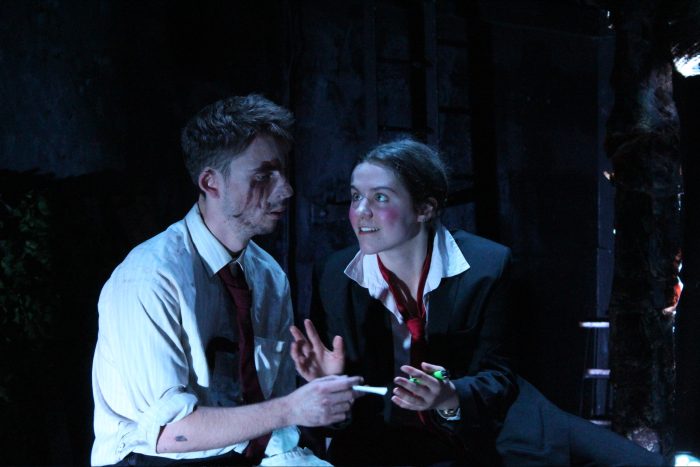We weren’t quite sure of what to expect from a theatre production called ‘GRAVE’, but the life-sized mound of dirt in the middle of the stage was certainly a surprise!
It was our first time visiting The Drama Barn, UOYs open theatre space, and we definitely weren’t disappointed with the show.
Together with the static buzzes of noise and red lights, the small theatre made us feel like we were inside a coffin!
The two-person cast completely commanded the stage, with a sometimes fearful presence which led usto ask ourselves ‘will I end up in the grave?’ before the show had even begun.
The role of ‘ONE’ (played by Sylvie Agnello) consisted of multiple characters, who antagonised the role of ‘TWO’ (played by Billy Truscott).
The audience watched as Sylvie was quickly transformed into several different absurd characters, each one, in turn, moulding the audience’s emotions and sending us down a journey of crafted disorder.
At the start of the play, the protagonist (TWO) was upbeat and spirited; a city lawyer, full of life.
His polite, if not forced, companionship with a rural gravedigger meshed the realms of life and death together in an utterly unique way.

Throughout the play, we saw the protagonist slowly decay and slip into the realm of death, to the point where he becomes absolutely unrecognisable by the end.
For a small stage, the cast really used the space, whether it was by dragging themselves along the floor, or circling the grave like vultures in a well-structured fight scene at the end.
One thing that was quite exacerbating was the fact that it left some questions unanswered.
We imagine the director and writer, William Osbon, received not only rounds of applause, but also rounds of questions at the end from the audience.
When interviewed after the play, Will said: “part of epic theatre or part of experimental theatre is leaving you without answers and going ‘well, make your own conclusions’”.
Above all else, GRAVE is definitely a performance that gets you thinking; thinking about the simultaneous passion and banality of life, and changing the perhaps not-so-obvious lines between the living and the dead.
It is also worth noting that the play featured two alternative endings; one on Saturday, another on Sunday. For Friday, the lucky audience got to decide which of the two endings would play out.
Osbon told SCENE “Only by seeing both endings do you get any idea of resolution…I think it’s that unfulfilling element of splitting it in two that was so enticing”.
This piece carried home the simple, if somewhat ‘grave’, message that ‘Life ain’t easy. We’re all just trying to get by’.
But beyond that, it also tackled real current issues such as identity and alcoholism, including the feeling of despair that accompanies the ‘stagnation’ of life.
This was not a play detached from reality, but rather, one embedded within multiple.
